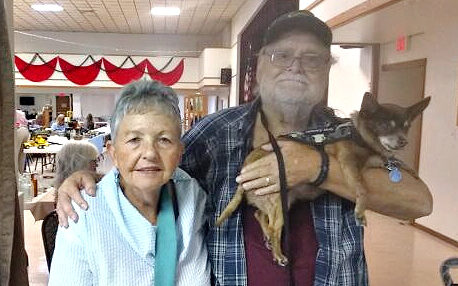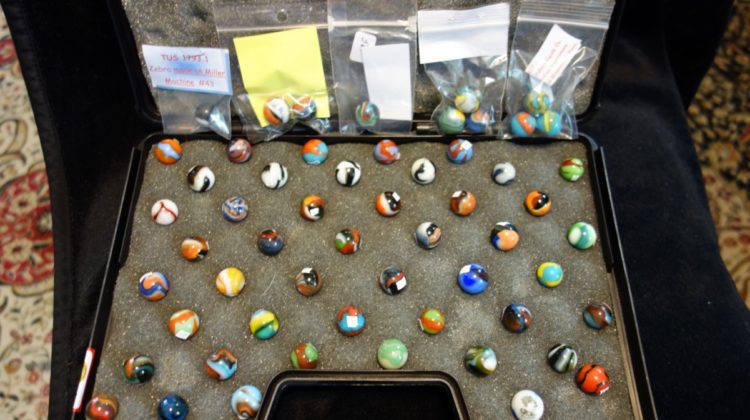
“If you don’t know history, then you don’t know anything. You are a leaf that doesn’t know it is part of a tree.” – Michael Crichton
How many marbles ya’ got?
When we tell people about our marble hobby and collection one or two questions invariably come next. It’s a tie between “How many ya’ got?” and the old chestnut “Have you lost your marbles?” For some reason people still think that’s funny. And some people we hardly know at all will sometimes ask “What are all of your marbles worth?” or “Very pretty, but are they worth anything?”
We have only been collecting marbles and marble-related stuff for about eighteen years. We have written about some our collection in related stories in this eMagazine: “Bobby Dazzlers…,” “Rats & ‘Knuckle Down’”, and “More Marble Collectibles.”
That’s a lot of marbles!
Believe it or not, and just because we were curious, we started counting our marbles when we started collecting. Sure, some of the total are “eye candy”. We enjoy all of those too. We have all kinds of antique and modern jars full as well as a glass skull, an antique light green milliner’s head, an old glass dough roller, gum ball machines of all kinds and sizes (one floor model), and even a restored 1950s parking meter head sitting on top of a tall glass pedestal. Needless to say, we do enjoy our eye candy.
We have a bit over 63,000 marbles. This isn’t many considering that we know one collector couple who have over 6,000,000. We know several others with well over a million.
What is a lot is this: we have sorted, sized, graded, and identified at least 10,000 of our marbles. Some are rare antiques, others contemporary handmade, and some we dug or found (over 2,700 so far—see “Far-Flung in Wimauma” in this eMagazine), and the majority form the heart of our collection which is 20th Century American glass. We have marbles from all over the world, too!
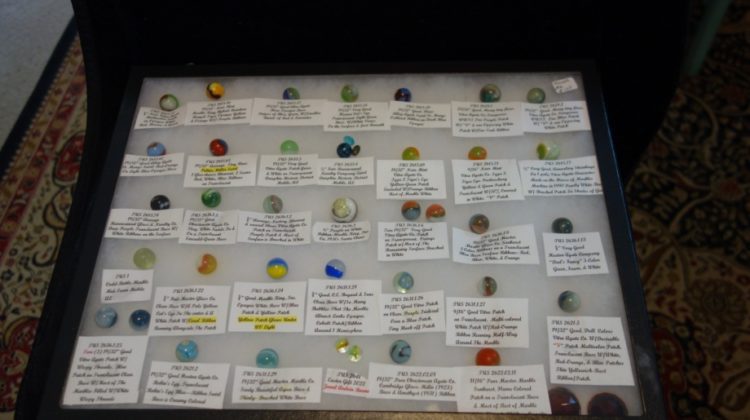
That’s a lot of work!
We spend a few hours a week sorting and identifying our marbles and we have done since we started collecting. We camped for years and even then when we had a rainy day we would sort, identify, and write notes about the marbles.
This is a sample of one of our black display cases. They are different depths: ½”; ¾”; and over one inch. We have filled over 100 of these black cases! Our most interesting, valuable, or historically significant are stored in these cases.
We make notes about each marble using all the references we can find, and then type up a short label with the marble size, grade, maker, and colors. The labels go into the cases with their marbles. Each label includes an assigned number which links the marble(s) to a longer description; these full write-ups go into a series of notebooks which constitute a collection catalog.
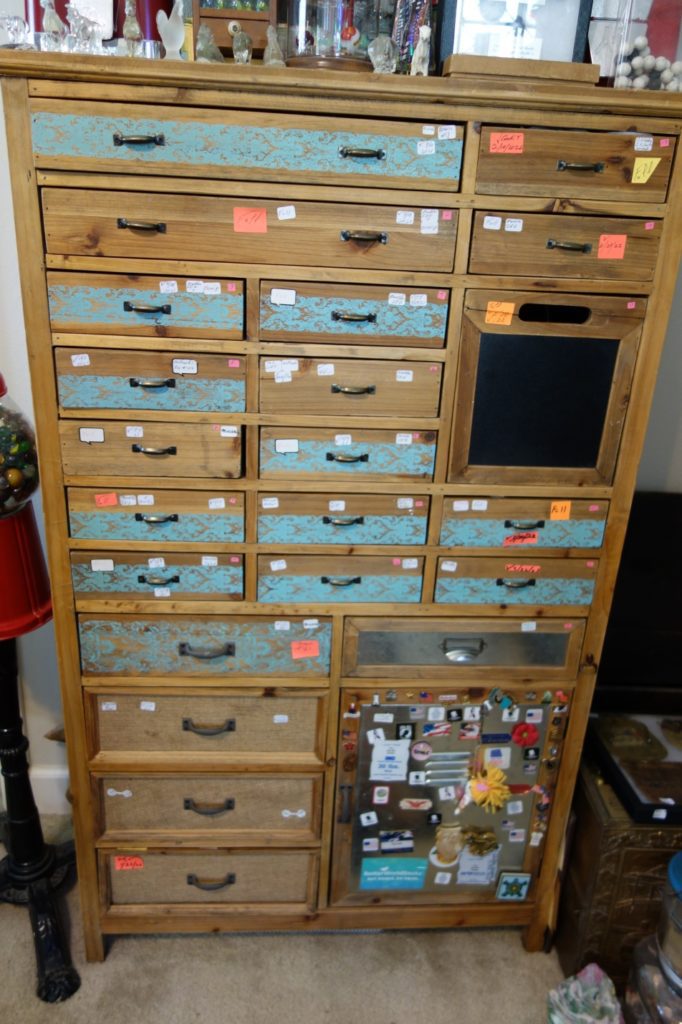
Sometimes we are stumped and call marble makers, friends in the marble community, brokers, and we go online to the many marble blogs we belong to. It has taken us weeks to sort through a lot (or grouping) of marbles we bought in a shop or at a show. This cabinet is jam packed with identified marbles and original marble bags. We have a few fantasy and fake bags. These, too, tell a story!
The provenience of marbles
It is impossible to know the provenience of every marble, or even the provenance for that matter. Provenience is an archaeological term which refers to the exact spot where an artifact was dug or found, sometimes including how deep the artifact was dug.
When we find or dig a marble we write where we found it, when, and any historical notes about the location. So far we have found marbles in over 230 different communities from Key West to central Ohio. And one older marble in Black Hawk, Colorado, and even one in the deserts of the Middle East!
Marbles are a key element in the cultural history of a place and its people. The age of the marble, the material it is made of, and the physical location at the approximate time it was lost tells a lot about a community and the children who once lived there.
The provenance of marbles
Provenance is the detailed history of where a marble has been since it was made. This is our favorite part of collecting. We love to talk to people, some of whom we buy marbles from, and the stories can be fantastic! Over and over again we have learned new stories of how children loved marbles and played with them in the 1920s – World War II. So far we have gathered enough provenience and provenance information to fill The Secret Life of Marbles and over twenty posts in this eMagazine!
Marbles are time capsules and can be cultural survivors, sometimes long after the culture itself is gone. We love to research the history of a place and its people. You would be astounded what a small circa 1820 primitive clay marble painted with a tiny Cherokee rose told us about the ghost town where we found it. The people, the town itself may be long gone. But not the marble.
The Long, Long Catalog
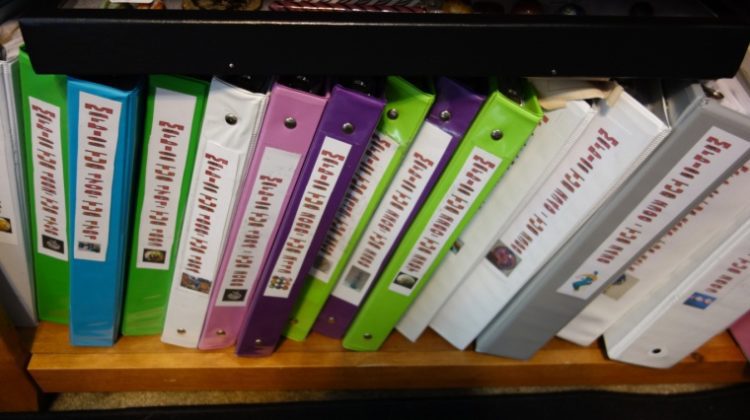
As we mention above,. when we place the marbles in a display case we assign a unique lot number which is linked to a catalog. The pages of the catalog run consecutively across the notebooks, as do all the marble numbers. The last page of the notebook we are writing now is numbered about 2,260! There are over 5,000 lots. So far.
The notebooks are what used to be called a supra-scrapbook. We write everything we can find about the marbles, and the binders also contain ephemera, receipts and business cards, handwritten notes and letters from others about particular marbles, even maps where we found marbles. It is really phenomenal that we have so much about each marble and that we have such a back story to our collection.
Rocks
The title of this story is “Rock and Roll….” The roll refers to glass, stone, clay, China, ceramic, marbles. Most do roll.
The rock refers to rocks. We first became interested in rocks, minerals, and semiprecious stones when we found got first German stone marbles.
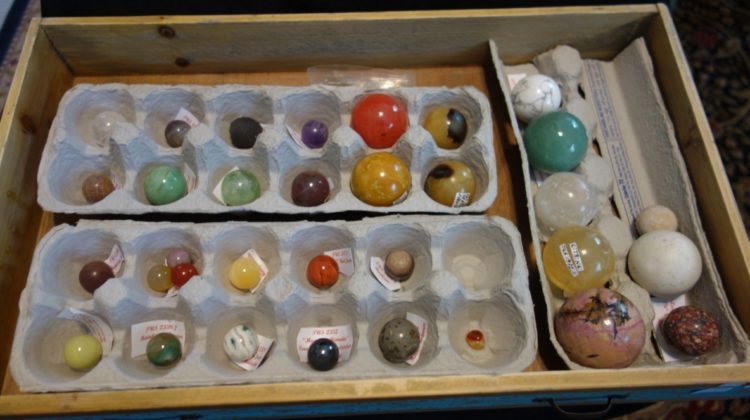
Our imagination really took off when we found some hand-cut bulls-eye Agates or carnelians in an old timers’ collection which we had bought. These were beautiful, and we collected an interview with a 90+ year old who love to play with these “California Agates.”
One thing led to another. This photograph is one drawer from the cabinet we showed earlier.
Now we have 150 different rocks, minerals, and gemstones. Ever heard of “Yooperlite”? We have an orb of it. White Phosphorus, Turquoise, Aqua Aura Quartz, Marble, Speleothem, Pipestone, Mookiate, Girasol Gemstone, Flint, Cave cobble? We have at least one sample of each. Yes, we admit, some are not “marbles” in the most narrow definition.
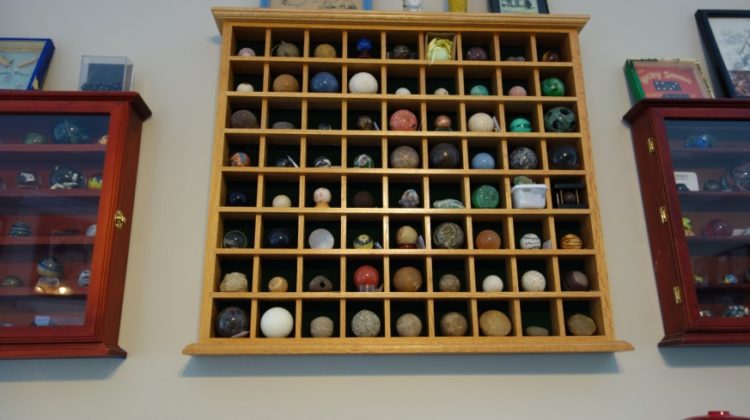
But some are. We watched artists make a number of the stone marbles. And, at any rate, like you, we feel that it is our collection to build and maintain any way we want. As you can see in the photograph we prefer shooter size minerals: about ⅞”. But should someone want to gift us a mineral we are not a stickler about size!
This wall rack shows off mostly stone and mineral marbles. Almost all of the bottom two rows were made and played by Native Americans. If you’re curious about how the First Americans made round marbles, check out the little book A Stone’s Throw by Darren Shell.
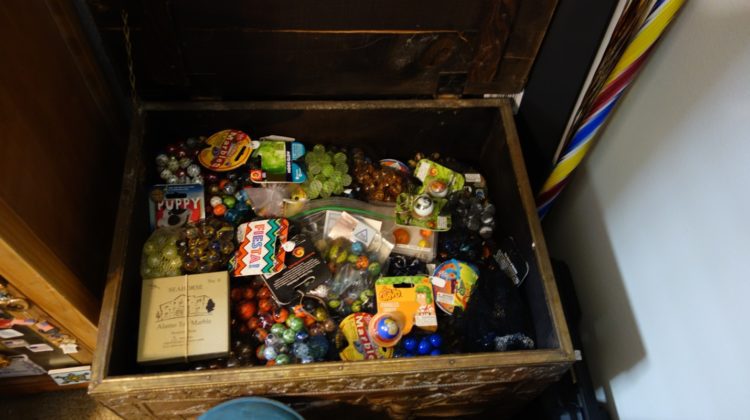
Vacor de Mexico (1930 – )
Check it out. This is an antique wooden kindling box covered in hammered brass. Inside are some 130+ original nets of Vacor marbles. Each and every net is listed, described, and annotated in the catalog and are counted on a spreadsheet. Many, if not most, of these marble nets have since been retired by the company.
We also have an antique two gallon jar, like those used in general stores to display and sell pickles, which is filled with over 700 individual Vacors. Of course, each, from players to toe breakers, is described and cataloged.
We started collecting Vacors several years ago when we were antiquing with Larry’s sister, Lynn G. Howell, in Pace, Florida. We found loose clay marbles in a dusty shop. We bought a few. It was years later that we learned that the marbles were distributed in nets by Vacor and they were called Rustic. They were a revival of Vacor’s early clays. We have never found a full net of these.
Vacor De Mexico (Glasfirma International S.a. De C.v, Guadalajara, Mexico) started making clay marbles in 1930 and glass in 1934. Legend has it, they made Cat’s Eye marbles in 1944.
We have especially enjoyed collecting Vacor, Mega, and now Play Vision marbles with Lynn. The various company names reference different distributors of the Mexican marbles in the United States. Vacor has made some remarkably beautiful glass marbles over the years. Lynn once gifted us with an original plastic bag containing 1,000 Vacor Pee Wees! Yep, it’s in the kindling box!
Can you help me out?
We have been asked this question many times by antique shop proprietors and individuals whom we have met along the way when they learn that we like marbles and know a little about them. Then, all too often, we experience the saddest thing we have ever seen while collecting marbles. The individuals show us a tub, coffee cans, a box, jars and jars (some broken), or a sack full of everything from antique German swirls, clay, stone, China, Agate, and American glass of every imaginable kind and size.
Some of the marbles have rust stains from the tins and some were played almost to dust. But some (is that a rolled commie?) are near mint. And then the question: “Can you sort these out right quick and tell me what they’re worth?”
No. We can sort, grade, and value them, but certainly not “right quick.” We have seen professional collectors sort by color quickly. But the difference, for example, in a Ravenswood and Alley swirl requires us to put a bit of thought into it.
For us the most tragic thing of all are those “grandpa’s lifetime collection” of thousands of marbles of all kinds which need to be cleaned, sorted, graded, sized, and appraised by next Tuesday. The estate sale, you know. The marbles often have no provenience or provenance. They are totally out of any historical or cultural context and the owner often knows nothing useful about their back story.
Like we said we have been doing this for eighteen years and we cannot imagine how you could appropriately accomplish the task it in a day or two.
Wrap it up
All marble collectors have their own methods of sorting and showing her or his collection. Our methods are certainly not “the best” because way there is no “best”. But we hope that we have given you a few ideas that you can use to better enjoy your own collection.
And we close with a question that we opened with. Are the marbles worth anything? The answer is yes. Some of our marbles are valuable. On the other hand, we have never bought marbles as an investment.
It is not the single marble which is worth something. Instead it is our collection as a whole, the history and mystery of it all, which appreciates the marbles. The collection has intrinsic value today and it will continue to be valuable long after we are gone.
Want to read more about our adventures with marbles? Read our book!

